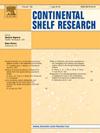低人类影响泻湖养殖牡蛎中微塑料和非合成微纤维的潜在人类消费风险
IF 2.2
3区 地球科学
Q2 OCEANOGRAPHY
引用次数: 0
摘要
沿海泻湖是生态和经济上重要的生态系统,作为海洋物种的育苗区,提供海岸保护,过滤污染物。尽管这些环境具有重要意义,但它们越来越多地暴露于各种污染物中,包括在全球生态系统中普遍存在的微塑料(MPs)和非合成微纤维(nsm)。由于它们的大小,它们可以被海洋生物摄入并转移到更高的营养水平,对海洋生物和人类健康构成风险。在墨西哥下加利福尼亚州农村沿海泻湖的养殖牡蛎(Magallana gigas)以及地表水、底水和沉积物中鉴定和量化了nsm和MPs。一旦样品被收集,有机物被去除,过滤,最后,颗粒根据它们的形状,颜色和大小被分离。采用μ-FTIR-ATR分析了颗粒的化学成分。最常识别的聚合物是纤维素、棉花和聚酯,在所有基质中都很常见。聚丙烯仅在地表水样品中占主导地位。这些发现突出了泻湖中MPs和nsm的不同来源和潜在行为。虽然泻湖的人为影响很小,径流有限,但它也不能免于污染。水、沉积物和牡蛎中MPs和NSMs的检测反映了沿海泻湖对污染物的脆弱性。这表明需要继续进行更好的监测,以了解对生态系统和人类健康的潜在影响。本文章由计算机程序翻译,如有差异,请以英文原文为准。

Potential human consumption risks from microplastics and non-synthetic microfibers in cultured oysters from a low-human-impact lagoon
Coastal lagoons are ecologically and economically important ecosystems, serving as nursery areas for marine species, providing coastal protection, and filtering pollutants. Despite their significance, these environments are increasingly exposed to various contaminants, including microplastics (MPs) and non-synthetic microfibers (NSMs), which are pervasive in ecosystems worldwide. Due to their size, they can be ingested by marine organisms and transferred to higher trophic levels, posing a risk to marine life and human health. NSMs and MPs were identified and quantified in farmed oysters (Magallana gigas) and in surface water, bottom water, and sediments from a rural coastal lagoon in Baja California, Mexico. Once the samples were collected, the organic matter was removed, filtered, and finally, the particles were separated according to their shape, color, and size. The chemical composition of the particles was analyzed using μ-FTIR-ATR. The most frequently identified polymers were cellulose, cotton, and polyester, common across all matrices. Polypropylene was predominant only in surface water samples. These findings highlight the diverse sources and potential behaviors of MPs and NSMs in the lagoon. Although the lagoon experiences low anthropogenic impact and limited runoff, it is not exempt from pollution. The detection of MPs and NSMs in water, sediment, and oysters reflects the vulnerability of coastal lagoons to pollutants. It suggests a need for continued monitoring better to understand potential implications for ecosystem and human health.
求助全文
通过发布文献求助,成功后即可免费获取论文全文。
去求助
来源期刊

Continental Shelf Research
地学-海洋学
CiteScore
4.30
自引率
4.30%
发文量
136
审稿时长
6.1 months
期刊介绍:
Continental Shelf Research publishes articles dealing with the biological, chemical, geological and physical oceanography of the shallow marine environment, from coastal and estuarine waters out to the shelf break. The continental shelf is a critical environment within the land-ocean continuum, and many processes, functions and problems in the continental shelf are driven by terrestrial inputs transported through the rivers and estuaries to the coastal and continental shelf areas. Manuscripts that deal with these topics must make a clear link to the continental shelf. Examples of research areas include:
Physical sedimentology and geomorphology
Geochemistry of the coastal ocean (inorganic and organic)
Marine environment and anthropogenic effects
Interaction of physical dynamics with natural and manmade shoreline features
Benthic, phytoplankton and zooplankton ecology
Coastal water and sediment quality, and ecosystem health
Benthic-pelagic coupling (physical and biogeochemical)
Interactions between physical dynamics (waves, currents, mixing, etc.) and biogeochemical cycles
Estuarine, coastal and shelf sea modelling and process studies.
 求助内容:
求助内容: 应助结果提醒方式:
应助结果提醒方式:


